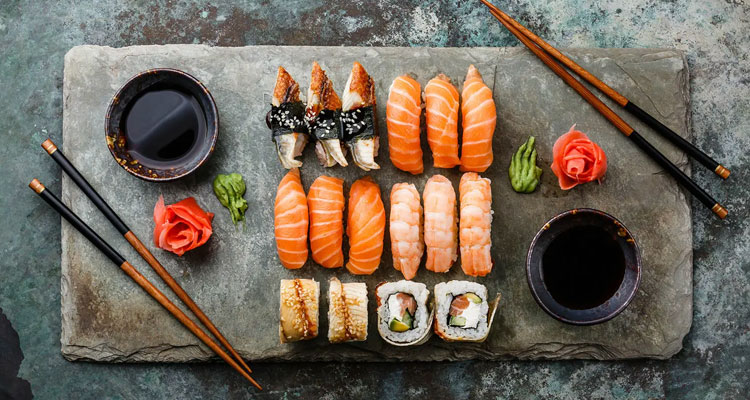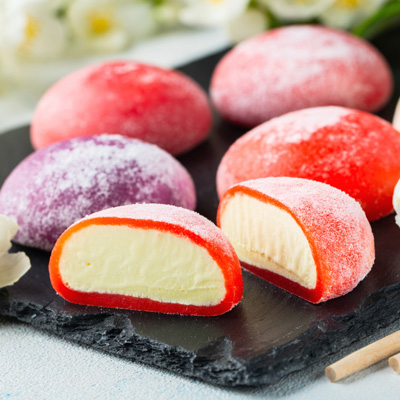Sushi, a dish that has captured the hearts and palates of food enthusiasts worldwide, is a testament to the artistry of Japanese cuisine. In this comprehensive guide, we embark on a culinary journey to unravel the mysteries of sushi, exploring its rich history, the delicate craftsmanship behind it, and the myriad flavors and styles that define this iconic dish.
Nutrition Facts
- Kcal
200 - Fat
1 g - Choles
0 mg - Sodium
500 mg - Carbs
45 g - Fiber
2 g - Sugar
2 g - Protein
4 g
Note: The nutrition facts are approximate values and may vary based on the specific ingredients used and any additional toppings or syrups added.
Ingredients
- 1 cup sushi rice
- 2 cups water
- 1/4 cup rice vinegar
- 1 tablespoon sugar
- 1/2 teaspoon salt
- 4 sheets nori (seaweed)
- Assorted fillings (e.g., cucumber, avocado, cooked shrimp, imitation crab, and smoked salmon)
- Soy sauce, for dipping
- Pickled ginger and wasabi, for serving (optional)
Directions
- Rinse the sushi rice under cold running water until the water runs clear. Drain well.
- In a saucepan, combine the rinsed rice and 2 cups of water. Bring to a boil, then reduce the heat to low, cover, and simmer for 18-20 minutes, or until the rice is tender and the water is absorbed.
- While the rice is cooking, mix the rice vinegar, sugar, and salt in a small bowl until the sugar and salt dissolve.
- Transfer the cooked rice to a large wooden or glass bowl. While it's still hot, gently fold in the vinegar mixture, using a wooden spatula or rice paddle. Be careful not to overmix; you want the rice to be slightly sticky.
- Lay a bamboo sushi rolling mat (or a piece of plastic wrap) on a clean surface. Place a sheet of nori, shiny side down, on the mat.
- Wet your fingers to prevent the rice from sticking, then spread a thin layer of sushi rice evenly over the nori, leaving about 1 inch at the top edge of the nori without rice.
- Arrange your choice of fillings in a horizontal line, slightly below the center of the rice.
- Lift the edge of the bamboo mat closest to the fillings and start rolling the nori over the fillings, using the mat to shape and compress the roll. Continue rolling, applying gentle pressure, until you reach the edge of the rice.
- Moisten the exposed edge of the nori with a bit of water to seal the roll.
- Repeat the process with the remaining nori sheets and fillings.
- Using a sharp knife, wet it slightly and slice each roll into bite-sized pieces.
- Serve the sushi rolls with soy sauce for dipping and, if desired, pickled ginger and wasabi.
The History of Sushi
- Origins of Sushi
Sushi's origins date back to ancient Japan, where it was initially a method of preserving fish by fermenting it with rice and salt. Over centuries, sushi evolved, and its preparation techniques became more refined.
- Edo-Style Sushi
During the Edo period (17th-19th century), sushi as we know it today began to take shape. Edo-style sushi featured vinegared rice combined with various toppings, such as seafood and vegetables, and was sold at food stalls.
- The Sushi Revolution
In the 20th century, sushi underwent a global transformation. Sushi chefs traveled the world, introducing the art to international audiences. The California roll, a maki sushi variation with avocado and crab, played a pivotal role in sushi's global popularity.
Crafting the Perfect Sushi
- The Rice
Sushi rice, also known as shari or sumeshi, is the foundation of every sushi dish. It's seasoned with a blend of rice vinegar, sugar, and salt, imparting a delicate tangy flavor.
- Nigiri Sushi
Nigiri sushi features small, hand-pressed mounds of vinegared rice topped with fresh seafood, such as tuna, salmon, or shrimp. Precision and balance are crucial when crafting nigiri.
- Maki Sushi
Maki sushi, or sushi rolls, are created by wrapping vinegared rice and various ingredients in a sheet of nori seaweed. There are countless maki varieties, from classic cucumber rolls to adventurous tempura rolls.
- Sashimi
Sashimi isn't technically sushi, but it's often served alongside sushi. It consists of thinly sliced, exceptionally fresh raw fish or seafood and is revered for its purity and simplicity.
The World of Sushi
- Nigiri vs. Sashimi
Nigiri features rice and toppings, while sashimi is all about the pure, unadulterated taste of the fish. Both are staples in the world of sushi.
- Vegetarian Sushi
Sushi isn't limited to seafood. Vegetarian sushi options include cucumber rolls, avocado rolls, and inari sushi (rice-filled tofu pockets).
- Fusion Sushi
Fusion sushi combines Japanese tradition with international flavors. Examples include spicy tuna rolls and the aforementioned California roll.
Sushi FAQs
Is it safe to eat raw fish in sushi?
A: Yes, sushi-grade fish is carefully handled and frozen to eliminate parasites, making it safe to consume raw.
What's the purpose of wasabi and ginger with sushi?
A: Wasabi adds heat and flavor, while ginger serves as a palate cleanser between bites.
Can I make sushi at home?
A: Absolutely! Homemade sushi can be a fun and delicious culinary adventure. Start with simple rolls and work your way up.
Is soy sauce necessary for sushi?
A: While not necessary, soy sauce can enhance the flavor of sushi. Dip sparingly to avoid overpowering the taste.
What's the difference between sashimi and carpaccio?
A: Sashimi consists of thinly sliced raw fish, while carpaccio is typically thinly sliced raw meat, often beef or fish, served with various seasonings.
Can sushi be part of a healthy diet?
A: Yes, sushi can be a healthy option, especially when choosing lean fish and limiting high-calorie rolls.
Conclusion
Sushi is more than a meal; it's an exquisite culinary art form that reflects Japan's rich cultural heritage and the creativity of chefs worldwide. Whether you're savoring the simplicity of nigiri, the boldness of fusion rolls, or the purity of sashimi, each bite is an opportunity to appreciate the centuries-old tradition and innovation that define sushi. So, the next time you indulge in this iconic dish, do so with a newfound understanding and appreciation for the craftsmanship and flavors that make sushi a global gastronomic treasure.













